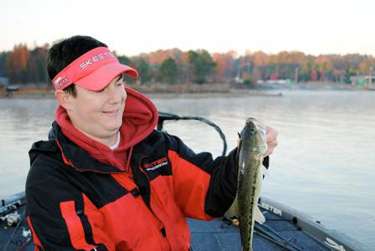
In Part 1 of this series, Will Petty covered fishing the hot water discharge area of power plant lakes, then relocating when the angler pressure increases.
By mid-day, the air temperature on our outing reached an unseasonably warm 60 degrees. Free of his coat, Petty fished a series of deep ledges and rock nearly a half mile from the discharge area where the surface temperature of the water was still 72 degrees.
“A football jig like this 3/8-ounce Jewell with a Paca Chunk trailer can load the boat on a hot lake.” Slowly hopping and dragging the jig across the rock below, he paused when he contacted a rock to shake the line.
This technique imitates a crawfish searching for cover. Petty then set the hook on a chunky 3-pound spot that was 20 feet deep. “They fight like crazy,” he said, “but be sure to release them quickly or know how to fizz them. Fish from deep water can have a hard time surviving.”
Idling over a shoal in the afternoon, Petty explained that he was looking for feeding schools of spotted bass.
The water temperature was 63 degrees.
“There’s not always surface activity to indicate feeding. The best thing to do is get comfortable with your graph. Learn what it can do and use it as a tool.” He quickly found an elusive school and eased the boat over it.
“I like to use a white Dave’s jigging spoon in a situation like this. That school is on fire,” he exclaimed, dropping the jig and working it vertically. “Just lift and drop the spoon on a semi-slack line. Don’t let it free fall or you’ll miss the strike. With a really good graph, you see the fish come up and eat it.”
In all, he plucked 13 spotted bass from that school. The last stop of the day was a dock in 55-degree water. “Like all lakes, hot lakes have brushpiles. This dock has a good one in 10 feet of water off the corner.” Petty tossed a white soft jerkbait with a 5/0 offset worm hook past the brushpile and retrieved it in short pulls. Suddenly, the line grews tight and the rod bowed!
“This is a monster spot,” Petty shouted, and the fight was on. “Holy cow! Look at that thing,” he said before the bass surrendered.
“There’s nothing like hot lake fishing. Nothing,” Petty remarked, releasing the bass after a quick photo. Power plant lakes will produce all year long, not just when it’s cold.
According to Petty, “A hot lake fishes a little bit like a river. Find the best current breaks and the best water temperatures, and you’ll find fish. I’ve been in tournaments when the air temperature was 20 degrees but the water was 60 degrees, and I caught a ton of fish. Search the water, match the forage for that temperature and find the best cover. You’ll find the fish.”
Originally published December 2010




